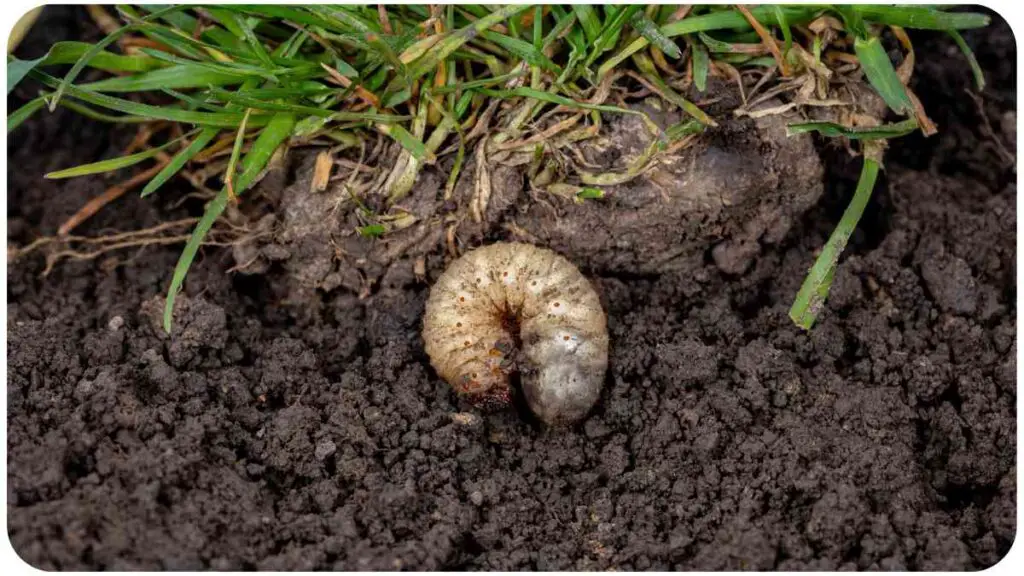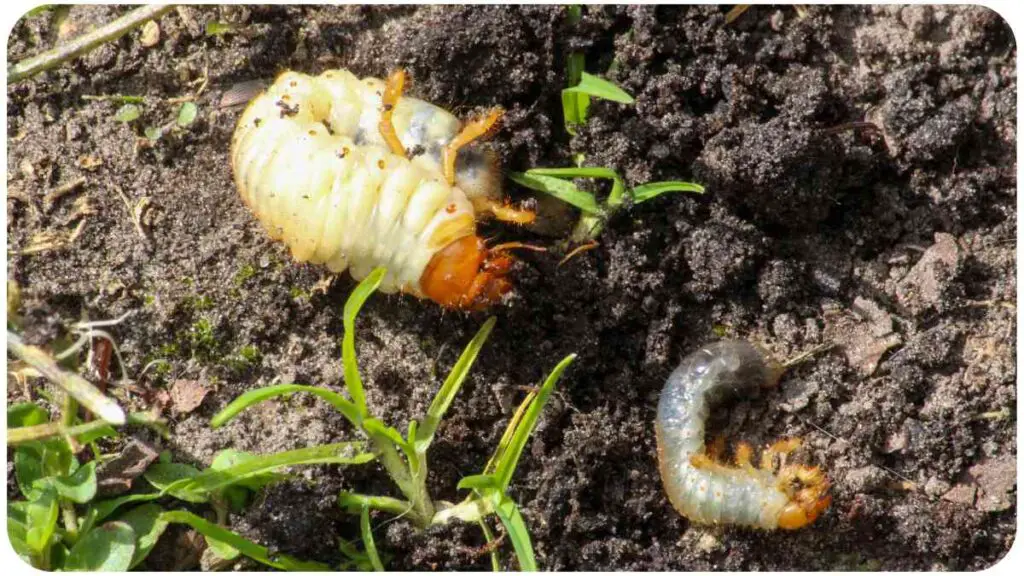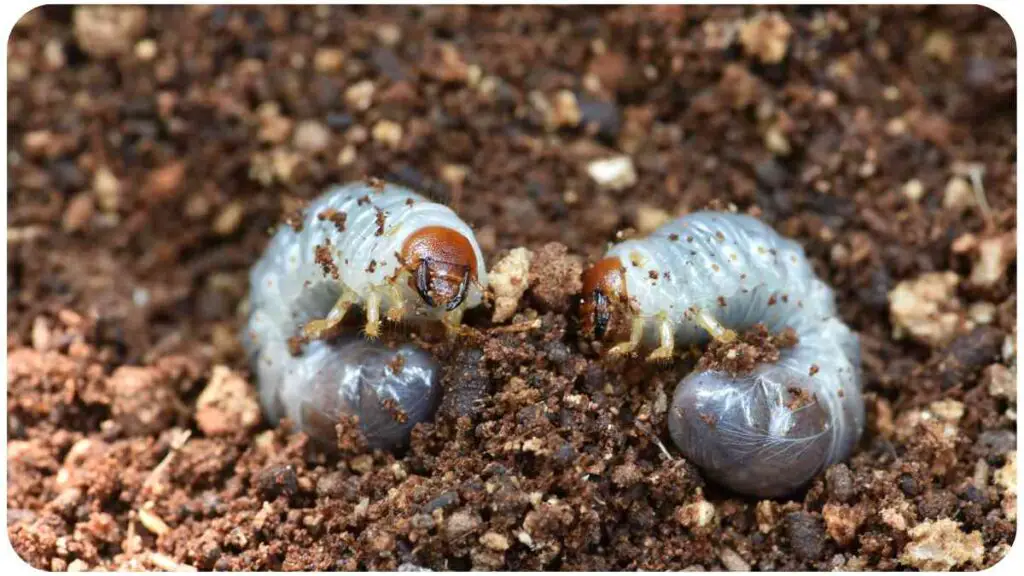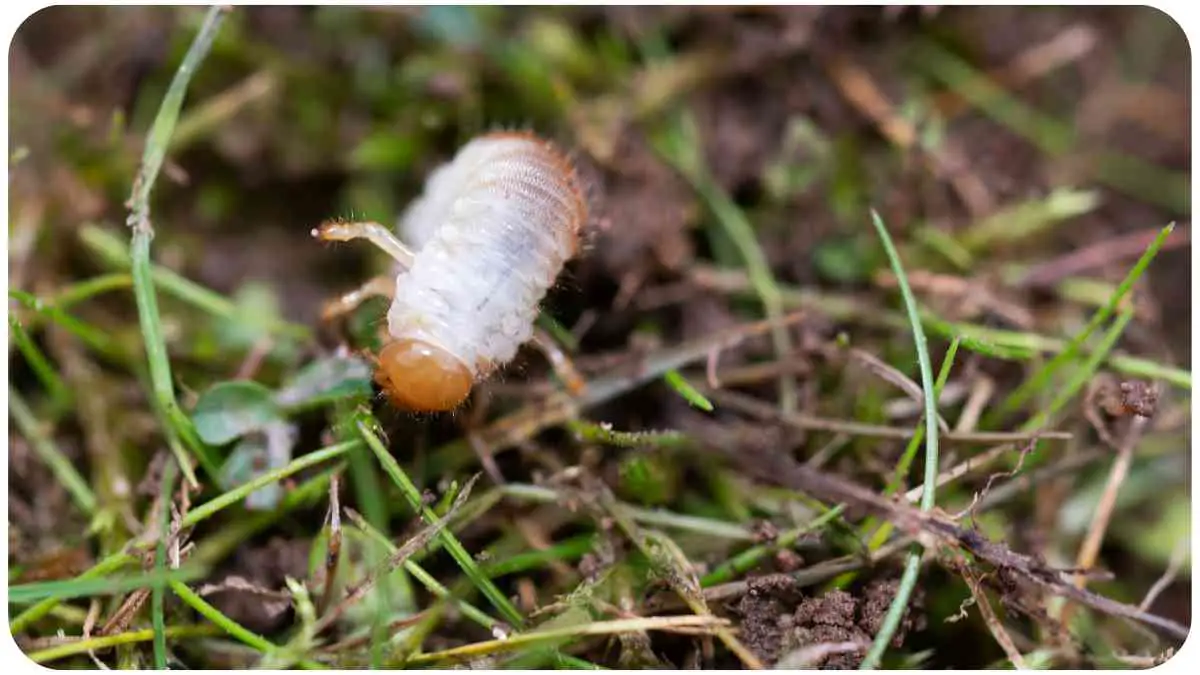If you’re a homeowner or gardening enthusiast, you’ve likely heard of lawn grubs and the havoc they can wreak on your lush green lawn. But how long do lawn grubs take to die once you begin treatment?
This comprehensive guide dives into the lifecycle of lawn grubs, the signs of infestation, and the various methods to eliminate them, including how long you can expect each method to take before seeing results.
| Key Takeaways |
|---|
| Understanding the lifecycle of lawn grubs is crucial for effective management. |
| Prompt action and proper timing are essential in treating and preventing grub infestations. |
| Chemical treatments, natural remedies, and biological controls offer different options for grub control. |
| Regular lawn maintenance is the foundation for preventing future grub infestations. |
| Being proactive and vigilant in monitoring your lawn can help catch grub infestations early. |
Understanding Lawn Grubs

What Are Lawn Grubs?
Lawn grubs, also known as white grubs, are the larvae of various beetle species such as Japanese beetles, June beetles, and European chafers. They reside in the soil, feeding on the roots of grasses and causing significant damage to lawns.
Types of Lawn Grubs
| Type of Beetle | Appearance | Common Regions |
|---|---|---|
| Japanese Beetle | Metallic green with copper wings | Eastern United States |
| June Beetle | Brown, hard-shell | Central and Southern US |
| European Chafer | Light brown, robust body | Northern United States |
Life Cycle of Lawn Grubs
Understanding the lifecycle of lawn grubs is crucial for effective management. Typically, their lifecycle includes the following stages:
- Egg: Laid in the soil during summer.
- Larva: The destructive stage, feeding on grass roots.
- Pupa: Transition phase before becoming adults.
- Adult: Beetles that lay eggs, continuing the cycle.
Signs of Lawn Grub Infestation

Visible Damage
Lawn grubs feed on grass roots, leading to brown, wilted patches on your lawn. If the grass feels spongy and can be easily pulled up, revealing white, C-shaped grubs, it’s a clear sign of infestation.
Testing for Lawn Grubs
To confirm an infestation, perform a simple test by cutting a small section of your lawn (around 1 square foot) and inspecting the soil underneath for grubs.
| Step | Action |
|---|---|
| 1 | Cut a square foot section of turf |
| 2 | Peel back the turf layer |
| 3 | Check for white, C-shaped grubs |
| 4 | Count the number of grubs |
Impact of Lawn Grubs on Your Lawn
Root Damage
Lawn grubs primarily feed on grass roots, which weakens the turf and leads to its death. This root damage makes the grass more susceptible to drought and disease.
Turf Health
A lawn grub infestation can severely impact the overall health of your lawn. As the roots are destroyed, the grass cannot absorb water and nutrients effectively, leading to thinning and browning of the turf.
Methods to Control Lawn Grubs
Chemical Treatments
Chemical insecticides are a common method for controlling lawn grubs. They are effective but must be applied correctly and at the right time for maximum efficacy.
Natural Remedies
Natural remedies include using neem oil, beneficial nematodes, and milky spore, which target grubs without harmful chemicals.
Biological Control
Biological control involves introducing natural predators like predatory insects and birds that feed on lawn grubs, helping to reduce their population naturally.
Chemical Treatments for Lawn Grubs
Types of Insecticides
| Insecticide Type | Example Products | Mode of Action |
|---|---|---|
| Neonicotinoids | Imidacloprid | Systemic, targets nervous system |
| Carbamates | Carbaryl | Contact and ingestion poison |
| Organophosphates | Chlorpyrifos | Disrupts enzyme activity in grubs |
Application Timing
The timing of insecticide application is critical. For instance, applying insecticides in late summer to early fall is most effective because grubs are small and more susceptible to treatment.
Effectiveness and Duration
Chemical treatments can take anywhere from a few days to a couple of weeks to effectively kill lawn grubs. The duration depends on the type of insecticide and the extent of the infestation.
Natural Remedies for Lawn Grubs
Neem Oil
Neem oil is a natural pesticide that disrupts the lifecycle of lawn grubs. It works by inhibiting their feeding and growth, eventually leading to their death.
Beneficial Nematodes
Beneficial nematodes are microscopic worms that parasitize lawn grubs, effectively killing them within a few days to weeks after application.
Milky Spore
Milky spore is a bacterium that specifically targets Japanese beetle larvae. Once applied, it can provide long-term control by infecting grubs and spreading naturally through the soil.
Biological Control for Lawn Grubs

Predatory Insects
Certain insects, like ground beetles, are natural predators of lawn grubs. Introducing these predators can help keep grub populations in check.
Birds and Wildlife
Encouraging birds and other wildlife that feed on grubs can also help manage grub populations. Birds such as robins and crows are known to dig for grubs in lawns.
When to Treat Lawn Grubs
Seasonal Considerations
The best time to treat lawn grubs is during their larval stage, which is typically late summer to early fall. This is when they are actively feeding and most vulnerable to treatments.
Monitoring and Timing
Regular monitoring of your lawn for signs of grub activity can help you determine the best time to apply treatments. Using a soil thermometer to check for soil temperatures around 60-70°F can also guide you in timing your applications effectively.
How Long Does It Take for Lawn Grubs to Die?
Factors Affecting Death Time
The time it takes for lawn grubs to die depends on several factors, including the type of treatment used, the size of the grub population, and environmental conditions such as soil temperature and moisture.
Preventing Future Lawn Grub Infestations
Regular Lawn Maintenance
Maintaining a healthy lawn is the first step in preventing grub infestations. This includes regular mowing, watering, and fertilizing to keep the grass robust and less susceptible to damage.
Preventative Treatments
Using preventative insecticides in the spring can help keep grub populations low. These treatments target eggs and early-stage larvae before they cause significant damage.
Common Mistakes to Avoid
Improper Application
One common mistake is improper application of treatments. Always follow the manufacturer’s instructions for the best results. Over-application can harm beneficial insects and the environment.
Ignoring Signs of Infestation
Ignoring early signs of a grub infestation can lead to severe lawn damage. Regular inspections and prompt action can save your lawn from extensive harm.
FAQs about Lawn Grubs
Do Lawn Grubs Only Affect Lawns?
While lawn grubs primarily affect lawns, they can also damage other plants with tender roots, such as garden vegetables and ornamental plants.
Are Lawn Grubs Harmful to Pets?
Lawn grubs themselves are not harmful to pets, but the insecticides used to control them can be. Always use pet-safe products and keep pets away from treated areas until it’s safe.
Expert Tips for Lawn Care
Best Practices
- Aerate Your Lawn: This helps reduce soil compaction and promotes root growth.
- Overseed: Regular overseeding can help maintain a dense turf that is more resistant to grub damage.
- Fertilize Wisely: Use a balanced fertilizer to provide essential nutrients for grass growth.
Seasonal Advice
- Spring: Apply preventative treatments and monitor for early signs of grubs.
- Summer: Water deeply but infrequently to promote deep root growth.
- Fall: Treat any existing grub infestations and prepare your lawn for winter.
Conclusion
Dealing with lawn grubs can be a frustrating experience, but with the right knowledge and tools, you can effectively manage and prevent infestations. Understanding the lifecycle of lawn grubs, recognizing the signs of infestation, and choosing the appropriate treatment method are crucial steps in maintaining a healthy, beautiful lawn. Whether you opt for chemical treatments, natural remedies, or biological controls, being proactive and vigilant will ensure your lawn remains grub-free and thriving.
Detailed Tables for Quick Reference
Types of Lawn Grubs and Their Characteristics
| Type of Beetle | Appearance | Common Regions |
|---|---|---|
| Japanese Beetle | Metallic green with copper wings | Eastern United States |
| June Beetle | Brown, hard-shell | Central and Southern US |
| European Chafer | Light brown, robust body | Northern United States |
Testing for Lawn Grubs
| Step | Action |
|---|---|
| 1 | Cut a square foot section of turf |
| 2 | Peel back the turf layer |
| 3 | Check for white, C-shaped grubs |
| 4 | Count the number of grubs |
Types of Insecticides and Their Characteristics
| Insecticide Type | Example Products | Mode of Action |
|---|---|---|
| Neonicotinoids | Imidacloprid | Systemic, targets nervous system |
| Carbamates | Carbaryl | Contact and ingestion poison |
| Organophosphates | Chlorpyrifos | Disrupts enzyme activity in grubs |
Expected Time Frames for Grub Control Treatments
| Treatment Type | Expected Time Frame |
|---|---|
| Chemical Insecticides | 1 to 2 weeks |
| Neem Oil | 2 to 3 weeks |
| Beneficial Nematodes | 1 to 2 weeks |
| Milky Spore | Several months to a year |
Further Reading
For more information on effectively managing lawn grubs and maintaining a healthy lawn, check out these resources:
- How to Choose and When to Apply Grub Control Products for Your Lawn: This comprehensive guide from Michigan State University provides valuable insights into selecting and timing grub control products for your lawn.
- How to Help Your Lawn Repair After Grub Damage: Learn effective strategies for repairing your lawn after it has been damaged by grub infestations with this informative article from Lawn Solutions Australia.
- Lawn Grubs: How to Kill: Discover various methods for eliminating lawn grubs and preventing future infestations with this helpful guide from LawnStarter.
FAQs
Do lawn grubs only feed on grass roots?
Yes, lawn grubs primarily feed on the roots of grass, which can lead to significant damage to lawns.
Are chemical treatments the only way to control lawn grubs?
No, there are natural and biological methods available for controlling lawn grubs, such as beneficial nematodes and milky spore.
Can lawn grubs harm other plants besides grass?
While lawn grubs primarily affect grass, they can also damage other plants with tender roots, such as garden vegetables and ornamental plants.
How can I tell if my lawn has a grub infestation?
Signs of a grub infestation include brown, wilted patches of grass that can be easily pulled up, revealing white, C-shaped grubs underneath.
Is it possible to prevent grub infestations?
Yes, regular lawn maintenance, including proper watering, mowing, and fertilizing, can help prevent grub infestations by keeping the lawn healthy and resilient.

Hi! My name is Hellen James, and I’m here to help you with your home-maintenance needs. Whether it’s building a better yard or just trying to fix a garden—I can show you how.


